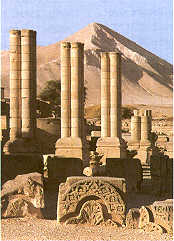
Jericho & The Dead Sea
Jericho lies twenty-two miles east of Jerusalem 260 meters below sea level making it the lowest town on earth. jericho and its surrounding area is one of the oldest continuously inhabited sites in the world. On a mount overlooking the jericho oasis, excavations have uncovered settlements dating from 9000 BC and the oldest walled town (7000 BC) yet discovered. jericho deserves a visit as the history is fascinating and the atmosphere with numerous outdoor cafes and excellent restaurants, is refreshingly laid-back.
Hisham's Palace
The site is 2km north of Jericho and was built by the Omayyad Calif, Hisham
Ibn Abdul Malek. The remains are of a magnificent winter palace which was destroyed
by an earthquake in 747 A.D shortly after construction. The site contains royal
buildings, a mosque, water fountains and spectacular mosaic floors.
Deir Quruntal and Monastery of Temptation
To climb up the bare, rocky slopes of Jabal Quruntul to the Monastery of the
Temptation might sound daunting, but in fact it is a trek of only 15-30 minutes.
The Greek Orthodox Monastery lies about 350m above Jericho, perched on a rocky
ledge about 31<m northwest of the town. The present monastery was built at
the end of the last century around a cave chapel that marks the stone on which
Jesus reputedly sat during the temptation. The spot is another of the holy sites
said to have been identified by Queen Helena in her pilgrimage of 326 A.D. Other
sources however date the place only as far back as the twelfth century.

Tell es-Sultan (ancient Jericho)
A little over 2 km northwest of jericho, Tell Es-Sultan is a huge mound of earth
covering 10,000 years of previous civilization dating from the Neolithic period.
The elaborate defenses include a seven meter high Neolithic Tower. It pre-dates
the Canaanite sites, of which there are no remains.
Nabi Musa
According to Muslim tradition, Nabi Musa, near jericho, is where Moses is buried.
The tomb of Nabi Musa (the prophet Moses) has been a site of annual pilgrimage
since the time of Salah Al-Din. The main body of the present shrine, however
was built by Mamluke Sultan Baybars in 1269. You can see a beautiful and serene
mosque, with a white domed roof, glazed green mihrab (prayer niche) and painted
green wooden minbar (pulpit).
The Dead Sea
The Dead Sea, 400 meters below sea level, is the lowest spot on the surface
of the earth. For miles around, arid hills eroded by wind form a silent moonscape
that is at once eerie and beautiful. The heavy salt (33%) water makes animal
life impossible and swimming an unusual experience. It is almost impossible
to sink. One can even lie on one's back and read a magazine. The Dead Sea is
a scenic oddity unique in the world.
Qumran and Ein Fashka
The archaeological site of Qumran lies at the northern end of the Dead Sea.
It consists of a monastery and the remains of a tower, kitchens, dining hall
and a "Scriptorium" (where the Dead Sea Scrolls were written) can
be seen. One can also find various cisterns, aqueduct and channels, evidence
both of the importance of water in the desert, and of the role ritual bathing
played in the life of the Essenes -a religious sect who first emerged around
150 B.C. This was their religious center from then until 68 A.D., when it was
destroyed by the Romans. At the far side of the site, one can look out to the
caves where the Scrolls were found.
Ein Fashka lies just three l<ms south of Qumran. Afresh water spring, whose waters tumble down from the hills leading down to the Dead Sea shores, creating pools of lush vegetation and attracting wildlife.